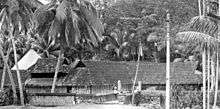Thirunadhikkara Cave Temple
| Thirunadhikkara Cave Temple | |
|---|---|
 Location in Tamil Nadu, India | |
| Location | Kanyakumari, India |
| Coordinates | 8°23′55″N 77°17′52″E / 8.3986°N 77.2977°E |

Thirunandikkara Cave Temple is a rock-cut cave temple of Pallava art dated to the seventh and eighth century AD. It is part of Thirunandikkara temple, which is near Thiruvattar in Kanyakumari district of Tamil Nadu state of South India. Up to the recent past before 1956, the region around the temple was part of Kerala but is now under the jurisdiction of Tamil Nadu. It was originally established by Jains in 7th century CE and later turned into Hindu shrine. [1][2]
The hall of the cave is conjectured to have had richly decorated paintings. However, at present only faded outlines remain over the passage of years. Dating of faded outlines of former frescoes from 9th–10th century. [1][2]Some of the earliest murals are in the Kerala style. The frescoes show scenes from the epic stories Ramayana and Mahabharatha. The frescoes or murals in this cave are reported to be the oldest antiquaries of Kerala style of murals.[2][3][4]
Natural pigments and vegetable colours were used in the earlier traditional style of mural art form which is the Fresco-secco style unlike the Buon Fresco technique. This art is being revived by a new generation of artists who are involved in researching and teaching mural art at the Sree Sankara Sanskrit College in Kalady and also at a Mural art school supported by the Guruvayoor Temple.[3][4]
Notes
| Wikimedia Commons has media related to Thirunadhikkara Cave Temple. |
- 1 2 "Kerala Murals". Kerala Murals. Retrieved 27 October 2012.
- 1 2 3 "Thirunadhikkara Cave Temple". Rediff.com. Retrieved 27 October 2012.
- 1 2 "Mural Paintings". Art Kerala. Retrieved 26 October 2012.
- 1 2 "Indian Mural Paintings". Kwint Essential. Retrieved 17 October 2012.